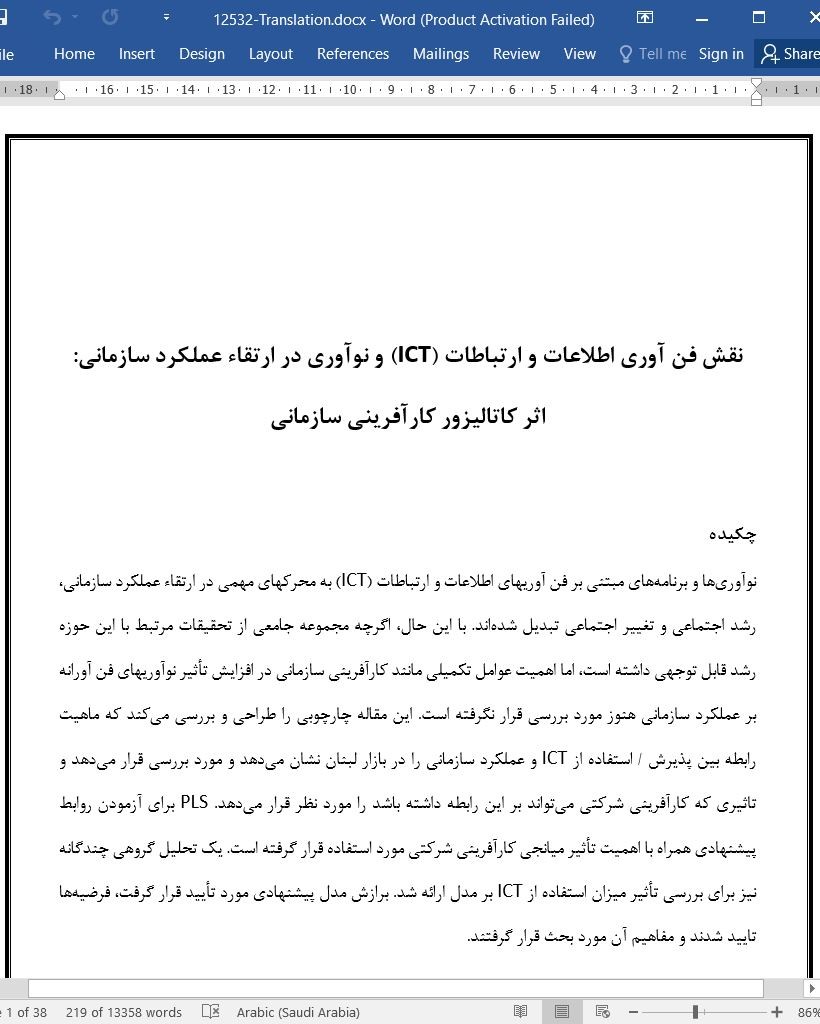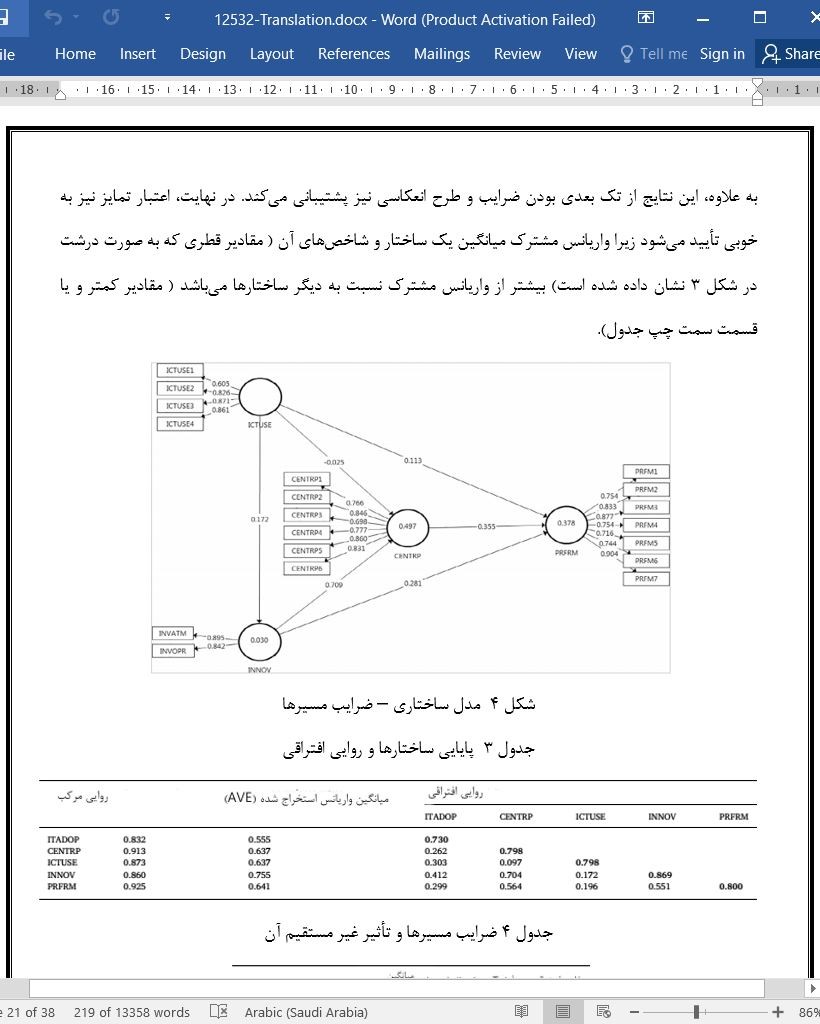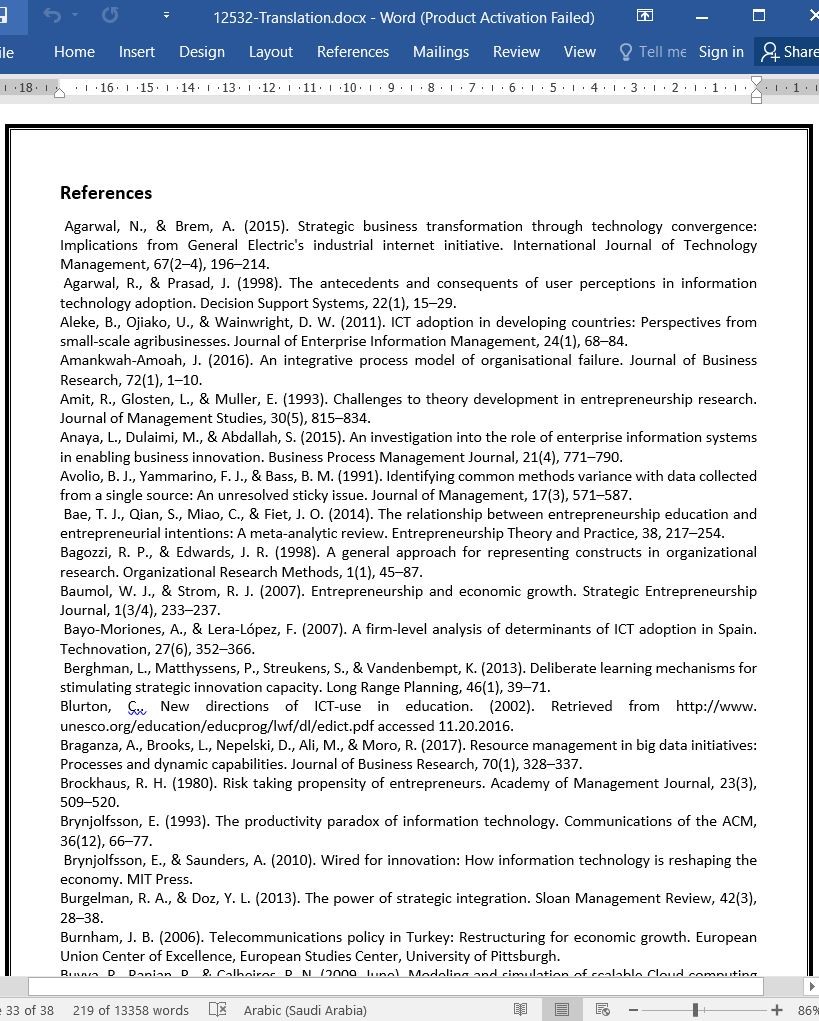
دانلود مقاله نقش فن آوری اطلاعات و ارتباطات (ICT) و نوآوری در ارتقاء عملکرد سازمانی
چکیده
نوآوریها و برنامههای مبتنی بر فن آوریهای اطلاعات و ارتباطات (ICT) به محرکهای مهمی در ارتقاء عملکرد سازمانی، رشد اجتماعی و تغییر اجتماعی تبدیل شدهاند. با این حال، اگرچه مجموعه جامعی از تحقیقات مرتبط با این حوزه رشد قابل توجهی داشته است، اما اهمیت عوامل تکمیلی مانند کارآفرینی سازمانی در افزایش تأثیر نوآوریهای فن آورانه بر عملکرد سازمانی هنوز مورد بررسی قرار نگرفته است. این مقاله چارچوبی را طراحی و بررسی میکند که ماهیت رابطه بین پذیرش / استفاده از ICT و عملکرد سازمانی را در بازار لبنان نشان میدهد و مورد بررسی قرار میدهد و تاثیری که کارآفرینی شرکتی میتواند بر این رابطه داشته باشد را مورد نظر قرار میدهد. PLS برای آزمودن روابط پیشنهادی همراه با اهمیت تأثیر میانجی کارآفرینی شرکتی مورد استفاده قرار گرفته است. یک تحلیل گروهی چندگانه نیز برای بررسی تأثیر میزان استفاده از ICT بر مدل ارائه شد. برازش مدل پیشنهادی مورد تأیید قرار گرفت، فرضیهها تایید شدند و مفاهیم آن مورد بحث قرار گرفتند.
1. مقدمه
در طی سه دهه گذشته، تحقیقات نشان داده است که سازمانها، کارآفرینی شرکتی را به منظور افزودن بر گسترۀ دانش خود برای کمک به افزایش درآمد (Mcgrath، Venkataraman، & MacMillan 1994)، بهبود سودآوری (Zahra، 1993)، افزایش رقابت پذیری (Kuratko، Covin & Garrett 2009) و نوآوری (Ferreira و همکاران، 2015) به عنوان یک محرک مهم رشد بالقوه آغاز کردهاند (Burgelman & Doz، 2013؛ Morris، Kuratko & Covin، 2011؛ Soriano & Huarng، 2013). این امر، درک عمیقتری از کارآفرینی شرکتی را در موقعیتهای سازمانی، به ویژه نقش آن در توانمند سازی فناوری اطلاعات و ارتباطات و نوآوری، و برای ادغام یکپارچه آنها در منابع و استراتژیهای سازمان تضمین میکند و در نتیجه عملکرد سازمانی را تا سطوح بالاتری ارتقاء میدهند.
محیط به سرعت متغیر کسب و کار، منجر به افزایش اتکا به فن آوری اطلاعات و ارتباطات، دستیابی و حفظ رقابت پذیری، بهبود سودآوری و موفقیت در بازار پویای امروزی شده است (Shamsuzzoha و همکاران، 2012، Stanimirovic، 2012). این محیط به محرکی برای فعالیتهای مرتبط با نوآوری تبدیل شده است که همه آنها تمایل به اتکا بر فن آوری دارند (Siegel، 2011) و برای دستیابی به کارآمدی بهتر و عملکرد بالاتر طراحی شدهاند (Consoli، 2005؛ Ferreira و همکاران، 2015، Igun، 2015). با این حال، علی رغم پذیرش گستردۀ فن آوری اطلاعات و ارتباطات توسط سازمانها در بخشهای مختلف، چندین مورد از گزارشات نظرسنجی، عدم موفقیت بسیاری از پروژهها را نشان میدهند. در سال 2012، Gartner گزارش کرد که کمتر از 30 درصد از پروژههای سیستم اطلاعات، مانند هوش کسب و کار، اهداف تجاری خود را برآورده میسازند (Saran، 2012) و 55 تا 75 درصد از پروژههای برنامه ریزی منابع سازمانی( (ERPدر برآورده ساختن اهداف مورد نظر با شکست مواجه میشوند، و 74.1 درصد از آنها هزینه بالایی دارند و 50 درصد به مزایای مناسبی دست پیدا نمیکنند (Jacobs، 2012). اخیراً، مطابق با یک مطالعه توسط KPMG، 70 درصد از کسب و کارها در طی سال 2014 شکست را تجربه کردهاند و 50 درصد از آنها نتوانستهاند که به اهداف مورد نظر خود دست پیدا کنند (Amankwah-Amoah، 2016؛ Erel، 2014).
7. کاربردها، محدودیتها و پیشنهادات این تحقیق
استفاده از ICT موضوع بسیار مهمی است که باید به خوبی بررسی شود. به صورت کلی، استفاده از ICT میتواند تنها در صورتی بر روی سازمان یا صنعت تأثیر داشته باشد که به صورت مبتکرانه استفاده شود. شرکتهایی که بیشترین بازگشت سرمایه از سرمایه گذاریهای ICT خودشان به دست میآورند، فراتر از خرید و استفاده از ICT میروند. همانطور که توسط Brynjolfsson و Saunders (2010) بیان شده است، این شرکتها به صورت مبتکرانه از ICT های خودشان استفاده میکنند و منجر به تغییر در روندهای سازمانی و تجاری میشوند. این مطالعه بیان میکند که میتوان در محیطی که از روحیهی کار آفرینی پشتیبانی میکند، این پتانسیلها را محقق کرد. بر همین اساس، ما در این تحقیق ، مقالات موجود در رابطه با نشر ICT را بررسی کرده و بیان میکنیم که ICT در صورتی یک تأثیر مثبت بر روی رقابت شرکت و عملکرد آن دارد که فرصتهای به دست آمده از نوآوری در ICT کسب شده و در فرهنگ سازمانی مطابق با کار آفرینی شرکتی، مدیریت شود. این کار آفرینی شرکتی که ما بیان کردهایم، میتواند بر روی تغییرات مورد نیاز در سازمان و سطح روندهای سازمانی تأثیر داشته باشد تا مزیتهای این فرصتهای ICT بهتر کسب شده و مدیریت شود. این موضوع مطابق این پیشنهاد است که باید میزان استفاده از تکنولوژی و درک الگوهای نشر بلند مدت آنها، ترکیب شوند.
Abstract
Information and communication technologies (ICT)-based innovations and applications have become major drivers of enhanced organizational performance, economic growth, and social change. However, although the body of research that is pertinent to this area has substantially grown, the importance of complementary factors such as corporate entrepreneurship in enhancing the impact of technological innovation on organizational performance has yet to be addressed. This paper develops and tests a framework that depicts and examines the nature of the relationship between ICT-adoption/use and organizational performance in the Lebanese market, taking into consideration the impact that corporate entrepreneurship may have on this relationship. PLS is used to test the proposed relationships along with the significance of the mediation effect of corporate entrepreneurship. A multigroup analysis is also deployed to examine the impact of ICT-use level on the model. The proposed model is proven to be fit, the hypotheses are supported, and the implications are discussed.
1. Introduction
Over the past three decades, the research has shown that organizations initiate corporate entrepreneurship to add to their body of knowledge to facilitate increased revenues (Mcgrath, Venkataraman, & MacMillan, 1994), improved profitability (Zahra, 1993), enhanced competitiveness (Kuratko, Covin, & Garrett, 2009), and innovativeness (Ferreira et al., 2015) as an important potential growth driver (Burgelman & Doz, 2013; Morris, Kuratko, & Covin, 2011; Soriano & Huarng, 2013). This warrants a deeper understanding of corporate entrepreneurship in organizational settings, especially the role it plays in enabling ICT and innovation to be well integrated into an organization's resources and strategies and consequently drive organizational performance to higher levels.
The rapidly changing business environment has led to increased reliance on ICTs to attain and maintain competitiveness, improve profitability, and succeed in today's dynamic market (Shamsuzzoha et al., 2012; Stanimirovic, 2015). This has been a driver of innovationrelated activities, all of which tend to be technology-based (Siegel, 2011) and are designed to obtain better efficiency and higher performance (Consoli, 2005; Ferreira et al., 2015; Igun, 2014). However, despite the wide adoption of ICT by organizations in various sectors, several survey reports have found that many projects fail. In 2012, Gartner reported that fewer than 30% of information systems projects such as Business Intelligence meet their business objectives (Saran, 2012) and that 55 to 75% of enterprise resource planning (ERP) projects encounter failure in meeting their intended objectives, with 74.1% of them exceeding costs and 50% not realizing enough benefits (Jacobs, 2012). More recently, according to a study by KPMG, 70% of businesses suffered project failures during 2014, and 50% failed to achieve their intended goals (Amankwah-Amoah, 2016; Erel, 2014).
7. Research implications, limitations, and recommendations
ICT use is a pivotal topic that needs to be examined. After all, an adopted ICT can affect an organization or an industry only if it is used innovatively. Companies with the highest levels of returns to their ICT investments go far beyond buying ICT resources and tools. As stated by Brynjolfsson and Saunders (2010), such firms innovatively use their ICT resources by introducing organizational and business process changes. This study suggests that these benefits can potentially be realized in an environment fostered by entrepreneurial spirit. Accordingly, this paper extends the existing literature on ICT diffusion by proposing that ICT use has a potential positive impact on a firm's competitiveness and performance if the opportunities derived from its innovation use are seized and managed within an organization culture marked by corporate entrepreneurship. This corporate entrepreneurship, we suggest, can affect the needed changes at the organization and process levels to better seize and reap the benefits of these opportunities. This conforms to the recommendations to jointly consider technology adoption and use to better comprehend their long-term diffusion patterns (Lanzolla & Suarez, 2012).
H1a. ICT use is positively related to Organizational performance.
H1b. ICT use is positively related to innovation.
H3a. Innovation mediates the relationship between ICT use and Performance.
H2a. ICT adoption is positively related to Organizational performance.
H2b. ICT adoption is positively related to innovation.
H3b. Innovation mediates the relationship between ICT adoption and Performance.
H4. ICT use moderates the above relationships.
H5a. ICT adoption is positively related to entrepreneurship.
H5b. ICT use is positively related to entrepreneurship.
H6a. Innovation is positively related to entrepreneurship.
H6b. Innovation mediates the relationship between ICT use and entrepreneurship.
H6c. Innovation mediates the relationship between ICT adoption and entrepreneurship.
H7. Corporate entrepreneurship is positively related to organizational performance.
H8. Corporate Entrepreneurship mediates the relationship between ICT and performance.
H9. Corporate Entrepreneurship mediates the relationship between Innovation and performance.
H10. Corporate entrepreneurship and innovation have a double mediation effect on the relationship between ICT use and Performance.
H1a. استفاده از ICT (فن آوری اطلاعات و ارتباطات) رابطه مثبتی با عملکرد سازمانی دارد.
H1b. استفاده از ICT (فن آوری اطلاعات و ارتباطات) رابطه مثبتی با نوآوری دارد.
H3a. نوآوری رابطه بین استفاده از ICT (فن آوری اطلاعات و ارتباطات) و عملکرد را میانجی گری میکند.
H2a. پذیرش ICT (فن آوری اطلاعات و ارتباطات) رابطه مثبتی با عملکرد سازمانی دارد.
H2b. پذیرش ICT (فن آوری اطلاعات و ارتباطات) رابطه مثبتی با نوآوری دارد.
H3b. نوآوری رابطه بین پذیرش ICT (فن آوری اطلاعات و ارتباطات) و عملکرد را میانجی گری میکند.
H4. استفاده از ICT (فن آوری اطلاعات و ارتباطات) روابط فوق را تعدیل میکند.
H5a. پذیرش ICT (فن آوری اطلاعات و ارتباطات) رابطه مثبتی با کارآفرینی دارد.
H5b. استفاده از ICT (فن آوری اطلاعات و ارتباطات) رابطه مثبتی با کارآفرینی دارد.
H6a. نوآوری رابطه مثبتی با کارآفرینی دارد.
H6b. نوآوری رابطه بین استفاده از ICT (فن آوری اطلاعات و ارتباطات) و کارآفرینی را میانجی گری میکند.
H6c. نوآوری رابطه بین پذیرش ICT (فن آوری اطلاعات و ارتباطات) و کارآفرینی را میانجی گری میکند.
H7. کارآفرینی شرکتی رابطه مثبتی با عملکرد سازمانی دارد.
H8. کارآفرینی شرکتی رابطه بین ICT (فن آوری اطلاعات و ارتباطات) و عملکرد را میانجی گری میکند.
H9. کارآفرینی شرکتی رابطه بین نوآوری و عملکرد را میانجی گری میکند.
H10. کارآفرینی شرکتی و نوآوری دارای تأثیر میانجی دوگانهای بر رابطه بین استفاده از ICT (فن آوری اطلاعات و ارتباطات) و عملکرد میباشند.
چکیده
1. مقدمه
2. چارچوب نظری
3. مروی بر مقالات و فرضیات
4. روش شناسی
4.1 نظر سنجی و جمع آوری دادهها
4.2 نمونه
5. نتایج
5.1 ابزار اندازه گیری و معیارهای ساختار مدل
5.2 تحلیل مدل خارجی
5.3 تحلیل مدل داخلی و تخمینهای مسیر
5.4 مدل پذیرش ICT
5.5 تاثیرات استفاده از IT بر روی مدل پذیرش ICT : تحلیل در چندین گروه
6. جمع بندی و مباحث
7. کاربردها، محدودیتها و پیشنهادات این تحقیق
منابع
ABSTRACT
1. Introduction
2. Theoretical framework
3. Literature review and hypotheses
4. Methodology
4.1. Survey and data collection
4.2. Sample
5. Results
5.1. Measurement instrument and construct measures
5.2. Outer model analysis
5.3. Inner model analysis and path estimates
5.4. The ICT adoption model
5.5. IT use effects on the ICT adoption model: multi-group analysis
6. Conclusion and discussion
7. Research implications, limitations, and recommendations
References
- اصل مقاله انگلیسی با فرمت ورد (word) با قابلیت ویرایش
- ترجمه فارسی مقاله با فرمت ورد (word) با قابلیت ویرایش، بدون آرم سایت ای ترجمه
- ترجمه فارسی مقاله با فرمت pdf، بدون آرم سایت ای ترجمه



